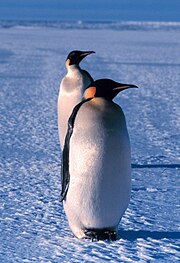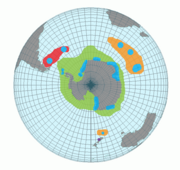Aptenodytes
|
Aptenodytes Temporal range: Pliocene to recent |
|
|---|---|
 |
|
| Emperor penguins | |
| Scientific classification | |
| Kingdom: | Animalia |
| Phylum: | Chordata |
| Class: | Aves |
| Order: | Sphenisciformes |
| Family: | Spheniscidae |
| Genus: |
Aptenodytes Miller,JF, 1778 |
| Species | |
|
Aptenodytes patagonicus |
|
 |
|
Aptenodytes patagonicus
Aptenodytes forsteri
Aptenodytes ridgeni (fossil)
The genus Aptenodytes (from the Ancient Greek a/α 'without' pteno-/πτηνο- "feather" or "wing" and dytes/δυτης "diver") contains two extant species of penguins collectively known as "the great penguins".
Ridgen's penguin (Aptenodytes ridgeni) is an extinct species known from fossil bones of Early or Late Pliocene age.
Combined morphological and molecular data have shown the genus Aptenodytes to be basal to all other living penguins, that is, the genus split off from a branch which led to all other species. DNA evidence suggests this split occurred around 40 million years ago. This had been foreshadowed by an attempt to classify penguins by their behaviour, which also predicted the genus' basal nature.
Two monotypic species extant:
...
Wikipedia
